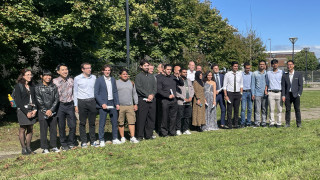Looking at the Universe through the "Betascope"

Science faces profound mysteries, chief among them the enigma of dark matter and why the universe has more matter than antimatter. These questions challenge our understanding of the universe's very fabric and are tackled by leading research centers like CERN, home to the Large Hadron Collider, and through deep underground experiments such as DUNE, PandaX, and LUX-ZEPLIN.
Ghost particles at the heart of understanding the universe
At the heart of this investigation are neutrinos, elusive particles that flit through matter unnoticed, earning them the nickname "ghost particles." Neutrinos are central to exploring the matter-antimatter conundrum, particularly through the lens of beta decays — processes where a single neutron transforms into a proton, releasing an electron and a neutrino.
— A focal point of this quest is the search for double-beta decays, a rare phenomenon where two neutrons undergo beta decay simultaneously, tells M.Sc. Marlom Ramalho.
Even more intriguing is the hypothetical neutrinoless double-beta decay, a process where no neutrinos are emitted, suggesting that neutrinos might be Majorana particles — entities indistinguishable from their own antiparticles.
Between the cosmic rays and the Earth’s own radiation
To accurately detect rare events like neutrinoless double-beta decays, scientists place their detectors underground. This minimizes noise from cosmic rays but introduces another challenge: interference from the Earth's own radioactive decay.
— This background radiation, particularly from beta decays, complicates measurements, and requires calibration explains Ramalho
While most beta decays follow predictable patterns, forbidden non-unique beta decays do not. They require complex calculations considering the nuclear structure involved. The challenge increases with the continuous nature of beta decays, where energy is split between an electron and an antineutrino.
— Precisely predicting and measuring these energy distributions is crucial for experiments seeking rare events, Ramalho emphasizes.
More precise computations are still needed
To counteract Earth's background radiation, detectors undergo careful calibration. However, this currently only partially solves the problem. Accurate modeling of forbidden non-unique beta decays is essential for distinguishing these rare events from background noise, making precise computations a necessity for these experiments.
— Our research underscores the complexity of beta decays and their pivotal role in probing the universe's profound mysteries. Through meticulous computation, this thesis illuminates unresolved aspects of beta decay processes, emphasizing their significance in advancing our quest to understand the cosmos, sums Ramalho.
The examination of M.Sc. Marlom Ramalho’s doctoral dissertation “The Nuances of β-Decay: Theoretical Computations and Their Applications for Beyond the Standard Model Physics” will be held on 26.4.2024 at 12:00 in Ylistönrinne, Kem4. The opponent is Dr. Xavier Mougeot (Universitè Paris-Saclay, France) and custos is Professor Jouni Suhonen (University of Jyväskylä). The examination is held in English.
Publishing information
The dissertation “The Nuances of β-Decay: Theoretical Computations and Their Applications for Beyond the Standard Model Physics” can be read on the JYX publication archive: https://jyx.jyu.fi/handle/123456789/94359






